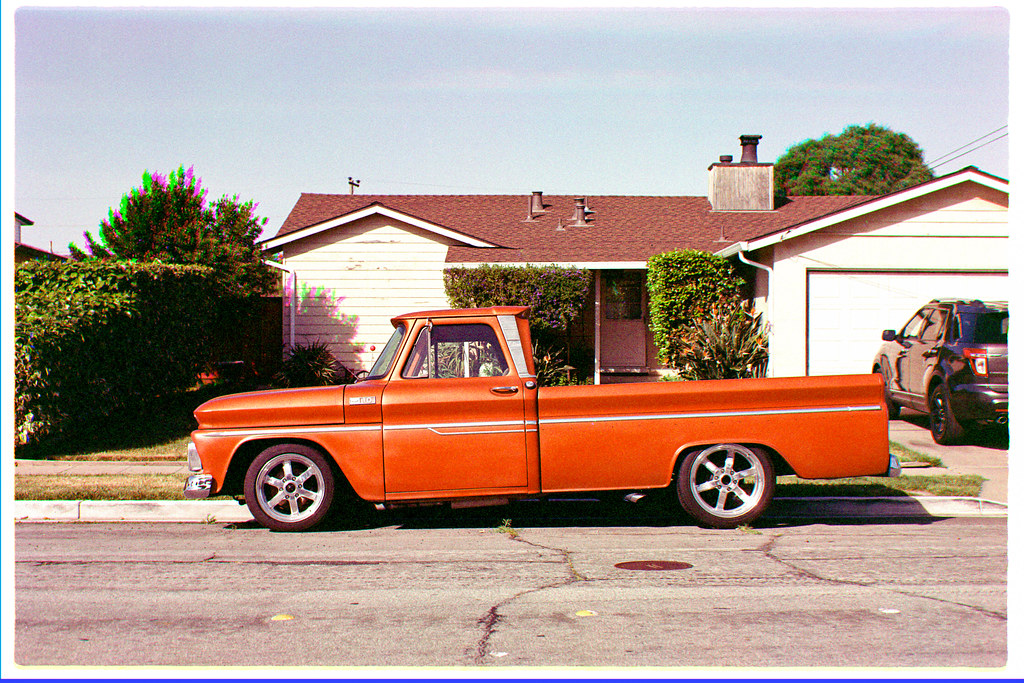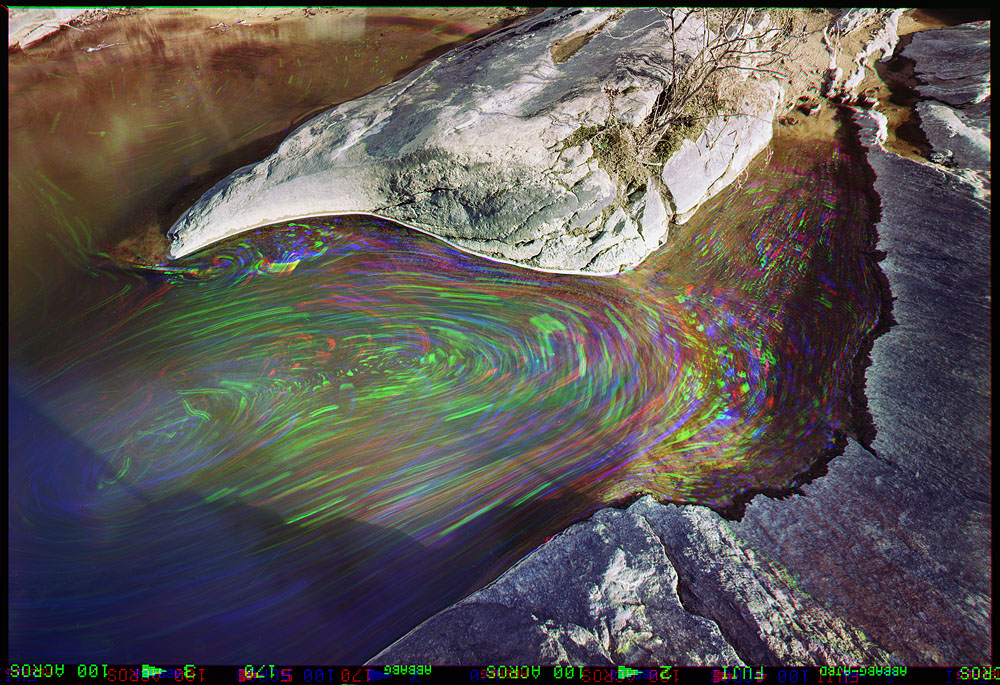dourbalistar
Buy more film
I'm not sure if this is the right subforum, but I did a search and didn't find another thread about trichromy. It's an old photographic process to create color images using black and white film, by combining three separate black and white photos, each shot through a red, green, and blue filter.
Since shelter in place has put a damper on my photo taking opportunities, I finally decided to try my hand at the technique. It's something I read about years ago, but hadn't gotten around to trying until now. Here are my first two attempts at trichromy. I don't think the colors are perfectly calibrated, but that's part of what makes them look kinda cool! Anyone else using this technique?
Nikon FM2n, AI Nikkor 50mm f/1.8S, Ultrafine Xtreme 400, developed in LegacyPro L110 at 1:31 for 5.5 minutes. Three individual black and white frames shot through Tiffen #25 Red, #58 Green, and #47 Blue filters, respectively, then combined using GIMP to create a trichrome color image.

2020.05.09 Roll #244-04711-positive-trichrome.jpg by dourbalistar, on Flickr

2020.05.09 Roll #244-04714-positive-trichrome.jpg by dourbalistar, on Flickr
Since shelter in place has put a damper on my photo taking opportunities, I finally decided to try my hand at the technique. It's something I read about years ago, but hadn't gotten around to trying until now. Here are my first two attempts at trichromy. I don't think the colors are perfectly calibrated, but that's part of what makes them look kinda cool! Anyone else using this technique?
Nikon FM2n, AI Nikkor 50mm f/1.8S, Ultrafine Xtreme 400, developed in LegacyPro L110 at 1:31 for 5.5 minutes. Three individual black and white frames shot through Tiffen #25 Red, #58 Green, and #47 Blue filters, respectively, then combined using GIMP to create a trichrome color image.

2020.05.09 Roll #244-04711-positive-trichrome.jpg by dourbalistar, on Flickr

2020.05.09 Roll #244-04714-positive-trichrome.jpg by dourbalistar, on Flickr
dfranklin
Established
Very cool. I love the color separation in the waving tree branches (and shadows of branches).
Chriscrawfordphoto
Real Men Shoot Film.
I've always wanted to try this and never did. The colors are surprisingly good, especially in the flower photo.
Ronald M
Mentor
Technicolor for stills.
CMur12
Well-known
I'm impressed!
It's hard to believe, just by looking at the images, that they weren't recorded on color film. (Though I understand that this was the technology of Technicolor.)
The flower shot is stunning.
- Murray
It's hard to believe, just by looking at the images, that they weren't recorded on color film. (Though I understand that this was the technology of Technicolor.)
The flower shot is stunning.
- Murray
Peter Jennings
Well-known
I remember seeing photos made by a Russian photographer who was working in the early 20th century using this technique. I found the process, as well as the photos, very fascinating.
dourbalistar
Buy more film
Very cool. I love the color separation in the waving tree branches (and shadows of branches).
Thank you, dfranklin!
I've always wanted to try this and never did. The colors are surprisingly good, especially in the flower photo.
Yeah, I was surprised by the color, I was expecting some funky color shifts.
I'm impressed!
It's hard to believe, just by looking at the images, that they weren't recorded on color film. (Though I understand that this was the technology of Technicolor.)
The flower shot is stunning.
- Murray
Thank you, Murray! For my first try, I'm thrilled with the results.
I remember seeing photos made by a Russian photographer who was working in the early 20th century using this technique. I found the process, as well as the photos, very fascinating.
Yes, that's the same photographer, Sergei Mikhailovich Prokudin-Gorskii, that piqued my interest in trying the technique. The Library of Congress has a great collection of his work online:
https://www.loc.gov/exhibits/empire/gorskii.html
maryland_fotos
Well-known
Very impressive!
ColSebastianMoran
( IRL Richard Karash )
Very interesting, thanks.
Some of us are experimenting with Tri-chromic illumination for camera-scan of color negatives. Theory is that narrow-band illumination will give cleaner colors. Jury still out.
For small still subjects, LEDs including some video lights can give you the R, G, and B illumination, may be cleaner trichromy than filters.
Some of us are experimenting with Tri-chromic illumination for camera-scan of color negatives. Theory is that narrow-band illumination will give cleaner colors. Jury still out.
For small still subjects, LEDs including some video lights can give you the R, G, and B illumination, may be cleaner trichromy than filters.
charjohncarter
Mentor
Those are great, did you have to 'remove cast' on them?
Dwig
Well-known
Very cool. I love the color separation in the waving tree branches (and shadows of branches).
Then you should checkout references to the "Harris Shutter", e.g. https://en.wikipedia.org/wiki/Harris_shutter
Vince Lupo
Nobody's Mentor
Thank you for shining a light on this - you results are super! I'd love to try this with my stereo images of Civil War battlefield sites that I'm currently doing.
Corran
Well-known
Occasionally use this for effects like this:


jwlee
Established
Here’s more on the subject.
<https://leicarumors.com/2020/01/29/color-photography-with-the-leica-m10-monochrom-camera-m10m.aspx/>
-John
<https://leicarumors.com/2020/01/29/color-photography-with-the-leica-m10-monochrom-camera-m10m.aspx/>
-John
dourbalistar
Buy more film
Very impressive!
Thank you, it's a lot fun!
Very interesting, thanks.
Some of us are experimenting with Tri-chromic illumination for camera-scan of color negatives. Theory is that narrow-band illumination will give cleaner colors. Jury still out.
For small still subjects, LEDs including some video lights can give you the R, G, and B illumination, may be cleaner trichromy than filters.
Wow, interesting, I never thought of doing it that way on the digitizing capture side. That's to get more accurate colors when digitizing color film, right?
Those are great, did you have to 'remove cast' on them?
I did have to do some work in post to remove a little bit of color cast. I'm mainly a B&W shooter, so editing color can be a bit overwhelming for me with all the temperature/tint/hue/saturation choices. At first, I considered leaving the color casts, but I did end up doing some correction. Like I said, maybe not exactly color accurate, but something interesting and I'm happy with the results.
Thank you for shining a light on this - you results are super! I'd love to try this with my stereo images of Civil War battlefield sites that I'm currently doing.
Thank you, I'm really happy with the results, especially for my first effort. I think the technique would lend itself really well to that subject! Might give it an antique "colorized" look that's different and unique, in stereo to boot!
dourbalistar
Buy more film
Occasionally use this for effects like this:

Corran, that's an awesome shot! I like how you left the edge markings on the rebate in your scan, that adds to the trichromy effect. I started with static objects, but I might try with some moving objects to see if I can get a similar effect.
dourbalistar
Buy more film
Here’s more on the subject.
<https://leicarumors.com/2020/01/29/color-photography-with-the-leica-m10-monochrom-camera-m10m.aspx/>
-John
Thanks for sharing, John! There's some good information in your link about which filters to use.
For those who are interested in experimenting using film, I followed the instructions on this blog post, using GIMP to create the color image. I did export to LR for some additional editing, dust spotting and color correction:
http://archive.brhfl.com/ph.brhfl.com/2012/09/07/gimp-trichromes/
Corran
Well-known
It took some doing to find suitable situations to get bright movement lines in the water. I've made a couple similar images. I would like to make more but I don't always bring every necessary item to do it, nor do I often want to blow 3 sheets/shots to see if it works (I've tried many times and gotten ho-hum results that don't show such clear movement). Good luck!
DominikDUK
Well-known
If you have to much money you could also buy one of these.
A bermpohl System Miethe three colour camera. The Russian photographer used one of the earlier versions of this camera.
https://www.leicashop.com/vintage_d...as/bermpohl-tri-color-camera-sku31295-13.html
A bermpohl System Miethe three colour camera. The Russian photographer used one of the earlier versions of this camera.
https://www.leicashop.com/vintage_d...as/bermpohl-tri-color-camera-sku31295-13.html
Neat idea for some experimentation!
Back in 1983 I had a similar thought with results more like Corran's because parts of the subject moved between exposures.
But, I used color neg film and did three color-separation exposures in a triple exposure on the same bit of film. No need to scan and superimpose the images.
Color separation filter multiple exposure experiment:
Bought this old Argus C3 for $10 because it has shutter cocking separate from film wind, making multiple exposures very easy.
Idea here is that three suitable exposures of the same stationary subject through each of the three filters, #25 Red, #58 Green, and #47 Blue, will add up to the same density and color balance as one exposure without any filter. But if any part of the subject moves between exposures, there should be some interesting and unusual color effects, limited of course to those things that moved and areas they obscure.
How about waves or a waterfall?
Back in 1983 I had a similar thought with results more like Corran's because parts of the subject moved between exposures.
But, I used color neg film and did three color-separation exposures in a triple exposure on the same bit of film. No need to scan and superimpose the images.
Color separation filter multiple exposure experiment:
Bought this old Argus C3 for $10 because it has shutter cocking separate from film wind, making multiple exposures very easy.
Idea here is that three suitable exposures of the same stationary subject through each of the three filters, #25 Red, #58 Green, and #47 Blue, will add up to the same density and color balance as one exposure without any filter. But if any part of the subject moves between exposures, there should be some interesting and unusual color effects, limited of course to those things that moved and areas they obscure.
How about waves or a waterfall?
Share:
-
This site uses cookies to help personalise content, tailor your experience and to keep you logged in if you register.
By continuing to use this site, you are consenting to our use of cookies.

